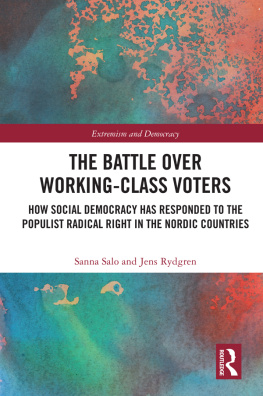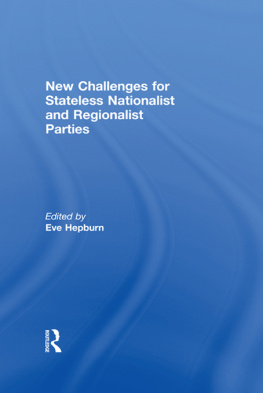Published by
Berghahn Books
www.berghahnbooks.com
2016 Anders Hellstrm
All rights reserved. Except for the quotation of short passages for the purposes of criticism and review, no part of this book may be reproduced in any form or by any means, electronic or mechanical, including photocopying, recording, or any information storage and retrieval system now known or to be invented, without written permission of the publisher.
Library of Congress Cataloging-in-Publication Data
Hellstrm, Anders.
Trust us : reproducing the nation and the Scandinavian nationalist populist parties / by Anders Hellstrom.
pages cm
Includes bibliographical references.
ISBN 978-1-78238-927-9 (hardback) ISBN 978-1-78238-928-6 (ebook)
1. Political partiesScandinavia. 2. NationalismScandinavia. 3. PopulismScandinavia. 4. MulticulturalismPolitical aspectsScandinavia. 5. ScandinaviaEthnic relationsPolitical aspects. 6. ScandinaviaPolitics and government. I. Title.
JN7066.H45 2015
324.21830948dc23
2015013053
British Library Cataloguing in Publication Data
A catalogue record for this book is available from the British Library
ISBN: 978-1-78238-927-9 (hardback)
ISBN: 978-1-78238-928-6 (ebook)
To my parents, who from the very start put their trust in me and always encouraged further accomplishments.
PROLOGUE
Stockholm. Fall 1991. In the streets one evening there was a loud demonstration, with skinheads yelling Sieg Heil. This was a frightening experience and I stayed out of sight and silently listened to the demonstration. Later I found out that many of the participants in the demonstration were members of what was at the time an obscure organization/party called the Sweden Democrats (SD). Back then the party attracted massive media attention and it does now. Certainly, the reasons why the party appears frequently in the media spotlight differs today from 25 years ago, but the relation between the party and its media representations is yet highly contested.
In Stockholm that particular evening I was afraid. Since then, society has changed, as it always does. Sweden is not the same. The SD is not the same party. I have myself changed. It is always easier to handle individual fears by creating distance between ourselves and the object(s) of our fear. The alternative is to invest the time to seriously consider the roots of our fears, to recline on the psychologists chair, so to speak; but what we find in ourselves might be less than appealing. However, as a society we share a common responsibility to critically reflect on who we are as people and how we feel about living with strangers. There is no short cut. There is no easy way out.
We are ultimately afraid of ourselves, of our ability to live with strangers in increasingly diverse societies. These speculations have motivated me to write this book; this is not part of an effort to condemn the parties in the Scandinavian states that suggestively thrive on these emotions. Ultimately, this book comes from a desire of mine to understand the parties attempts to achieve, or perhaps maintain, credibility in the political competition for votes.
On 14 September 2014, soon after this book was written, there were national elections held in Sweden. The SD rose from 5.7 per cent to 12.9 per cent of the total votes and became the third largest party in Sweden. At the same time, the other political parties in the national parliament refused to collaborate with the party. The mass media and the cultural elite remain very negative towards the party and seemingly depart from the rhetorical idea that the SD voters are neither racist nor stupid, even if according to many chronicles and editorials in mainstream press voting for the SD is the wrong solution to the problems Sweden faces today (cf. Hellstrm and Nilsson 2010). Also, fractions of the electorate counter-mobilize against the SD in e.g. street manifestations or at their work places.
Everybody, vertically and horizontally, seemingly hates the party aside from the voters. If anything, this situation reminds us that crossing the electoral threshold is not enough to provide an impact on domestic politics. You also need to cross the threshold of credibility. This is what this book is about.
For their voters, the SD represents a credible voice against the elites, though. In the post-election trauma, explanations in the media for the SDs success point to correlations between municipalities with high unemployment rates and the electoral fortunes of the SD (Dagens Arena, 24 September 2014), while others instead emphasise that this postulated correlation lacks empirical support (Expo Idag Blogg, 17 September 2014). However, most analyses argue that dense immigration populations in the municipality do not always have significant effect on the electoral fortunes of the SD. It is not that simple. Looking more closely at the scholarly literature, from the voters perspective, the perceived congruence between the mainstream parties in the field of immigration policy sustains the propensity to vote for the SD as an alternative voice (Loxbo 2014).
The immigration issue resurfaces in numerous policy areas, from traditional welfare policy to the disputes over wolf hunting, but it is not (at least not always) the main issue in its own right. From the SD voters perspective, it is perhaps by now hard to distinguish between the two larger parties, the liberal-conservative party (Moderaterna) and the Social Democrats. The SD thus offers an alternative voice for people who are united in a feeling of not being listened to, but who yet refrain from blatant racism. If anything, the emergence and continuous electoral success of the SD has brought with it increased polarization in the public debate in Sweden. The Danish Peoples Party in Denmark and the Progress Party in Norway have brought with them similar tensions. If anything the development of these three parties in the three countries remind us of the polarization in the electorate all across Scandinavia.
NOTES
In the epilogue, I will further discuss recent events in Swedish politcs and also in Denmark and Norway.


















